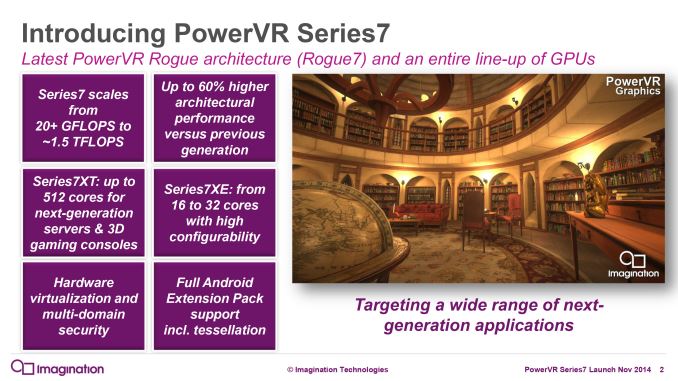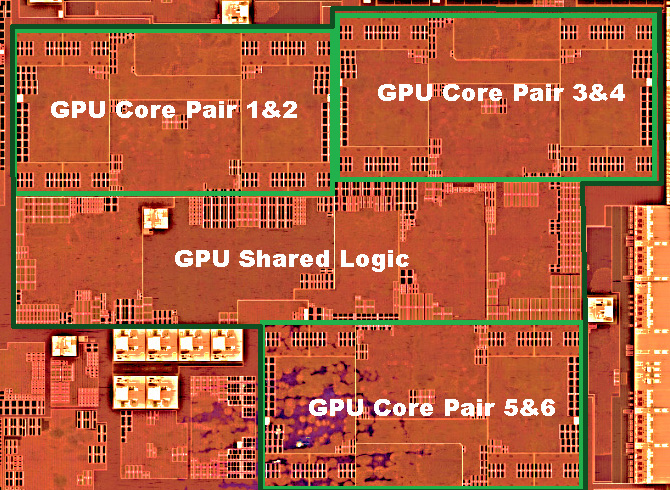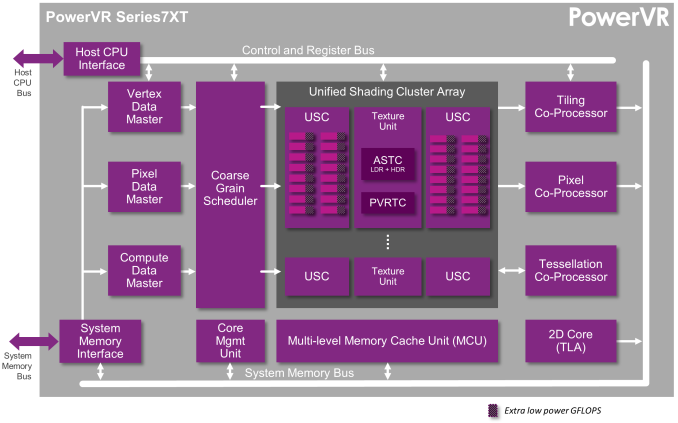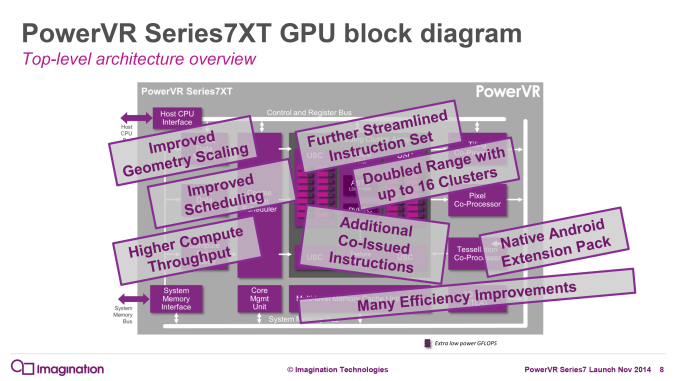The Apple iPhone 6s and iPhone 6s Plus Review
by Ryan Smith & Joshua Ho on November 2, 2015 8:00 AM EST- Posted in
- Smartphones
- Apple
- Mobile
- SoCs
- iPhone 6s
- iPhone 6s Plus
A9's GPU: Imagination PowerVR GT7600
With so much time spent talking about A9 from the perspective of its manufacturing process and its Twister CPU, it’s all too easy to forget that Apple has been working on far more under the hood than just CPU performance. As has been the case for generations now, Apple continues to focus on GPU performance, laying the groundwork for significant performance improvements with every generation.
Going all the way back to the first iPhone and its Samsung-developed SoC, Apple has been a patron of Imagination Technologies and their PowerVR GPUs. This has been a productive relationship for both parties, and for A9 this hasn’t changed. To no surprise then, the GPU in the A9 is another design in Imagination’s PowerVR Rogue family, the GT7600.
Briefly, while Apple continues to not disclose the GPU used in their designs – referring to the A9’s GPU as iOS GPU Family 3 v1 – a look at the iOS Developer Library makes it clear what GPU family is being used. Apple still uses tile-based deferred rendering GPUs (to which only PowerVR fits the description), so the only real questions are which family is in use and how many cores are present.
With A8 and its GX6450, there was a pretty clear smoking gun to identify the GPU family via the inclusion of ASTC support, a feature only available on Series 6XT and newer GPUs. There aren’t any such smoking guns on the A9, but the Metal Feature tables indicate that there are a handful of new low-level features which are indicative of a newer revision of the PowerVR Rogue architecture. Coupled with the fact that Imagination announced PowerVR Series 7 nearly a year ago and Apple has proven to be able to implement a new PowerVR design in under a year, and it’s a safe bet that A9 is using a Series 7 design.
As for the configuration, the A9 die shot quickly answers that one. There are 6 distinct GPU cores on the A9 die, divided up into 3 pairs with a shared texture unit in between them. So it may have taken Apple a generation longer than I initially expected, but with A9 we’re finally looking at a 6 core GPU design for the iPhone.
From a feature and design standpoint then, the GT7600 is not a significant departure from the GPUs in the A8 and A7 SoCs, however it does have some notable improvements along with some optimizations to boost performance across the board. Notably, relative to the GX6450 it features a geometry tessellation co-processor as a base feature, a function that was merely optional on Series6XT and, at least in Apple’s case not used. Unfortunately, looking through Apple’s developer documentation it does not appear that tessellation support has been added for Metal, so assuming for the moment that Apple hasn’t stripped this hardware out, they definitely don’t have API support for it.
Otherwise the bulk of Imagination’s focus has been on small tweaks to improve the Rogue architecture’s overall efficiency. Among these, the Special Function Units can now natively handle FP16 operations, saving power versus the all-FP32 SFUs of Series6XT. SFU operations can now also be co-issued with ALU operations, which improves performance when SFUs are being issued (which in Imagination’s experience, has been more than expected). Finally, the Vertex Data Master (geometry frontend), Compute Data Master (compute frontend), and the Coarse Grain Scheduler have all been updated to improve their throughput, and in the case of the scheduler improving its ability to keep USCs from stalling on tile-interdependencies.
Looking at the broader picture, after initially being surprised that Apple didn’t jump to a 6 core design with A8, with A9 it makes a lot of sense why they’d do it now. GPUs have and continue to be the biggest consumers of memory bandwidth in high-performance SoCs, to the point where Apple has outfit all of their tablet-class SoCs with a wider 128-bit memory bus in order to feed those larger GPUs. Conversely, a 64-bit memory bus with LPDDR3 has always represented a memory bandwidth limit that would bottleneck a more aggressive GPU design. With the move to LPDDR4 however, Apple has doubled their memory bandwidth, and coupled with the larger L3 cache means that they now have the means to effectively feed a larger 6 core GPU.
Overall then, between the 50% increase in the number of GPU cores, Imagination’s architectural efficiency improvements, Apple’s own implementation optimizations, and what I don’t doubt to be at least a decent increase in the clockspeed of the GPU, Apple is promoting that A9 should see an incredible 90% increase in GPU performance relative to A8. And as we’ll see in our performance benchmarks, they are more than capable of delivering on that promise.
| Mobile SoC GPU Comparison | ||||||||
| PowerVR SGX 543MP3 | PowerVR G6430 | PowerVR GX6450 | PowerVR GT7600 | |||||
| Used In | iPhone 5 | iPhone 5s | iPhone 6 | iPhone 6s | ||||
| SIMD Name | USSE2 | USC | USC | USC | ||||
| # of SIMDs | 12 | 4 | 4 | 6 | ||||
| MADs per SIMD | 4 | 32 | 32 | 32 | ||||
| Total MADs | 48 | 128 | 128 | 192 | ||||
| Theoretical GFLOPS @ 300MHz |
28.8 GFLOPS | 76.8 GFLOPS | 76.8 GFLOPS | 115.2 GFLOPS | ||||
| Pixels/Clock | N/A | 8 | 8 | 12 | ||||
| Texels/Clock | N/A | 8 | 8 | 12 | ||||














531 Comments
View All Comments
IanHagen - Wednesday, November 4, 2015 - link
Would you be so kind and post some sort of source for the allegedly professional review that deemed the iPhone camera as really poor? I'll be waiting by the sea.hlovatt - Monday, November 2, 2015 - link
Fantastic review, particularly liked the deep dive on the CPU.It must be hard to ignore the nasty comments some people make because you don't like their favourite phone as much as some other brand. Rest assured that their are many more people who appreciate your efforts than those who seem to have way too much invested in their choice of phone.
FunBunny2 - Monday, November 2, 2015 - link
-- * Especially the SoCSo, yes or no (and show your work): the Apple Ax processors are modified ARM ref. devices simply by adding off-the-shelf functionality available to any engineer with an HDL/CAD/etc. workstation? Seems so from all the various descriptions, here and elsewhere.
extide - Monday, November 2, 2015 - link
No they are clean sheet implementations of the ARM v8 instruction set. No off the shelf ARM Cortex CPU is even remotely similar, they are all much narrower designs. This chip is honestly designed more like an Intel Core CPU than an ARM one. Too bad you can only get it in an iPhone :(Byte - Monday, November 2, 2015 - link
Im a hardcore MS hore and hate Apple. But their iPhones cannot be beat. Android STILL feels like Windows Mobile phone which I i've used years before smartphone was a thing, starting with Palms. I'm a bit disappointed with the new camera, but pictures still look better on an iPhone than S6 even with Samsungs far superior screens. Android only had a short uptick when iPhones were stuck in the low screen sizes, but now Apples stronghold is insane. It will only take a paradigm shift from actual phones to challenge that, which might be very soon.pliablemoosethebanned - Monday, November 2, 2015 - link
Ignore the idiots, great review guys.Caliko - Tuesday, November 3, 2015 - link
With Apple's track record,You have a better chance building a snowman in hell than get them to pay you for something.
Alexey291 - Tuesday, November 3, 2015 - link
So you're implying that they forfeit their marketing contracts? I'm just asking because you seem to be the resident apple expert hereBragabondio - Tuesday, November 3, 2015 - link
I guess, to avoid comments like the above you guys need to state in the summary if you are using Iphone, Android or s/g else as a daily driver.The idea is that all of us have our preferences and biases but sometimes when we like an ecosystem (or if we were more familiar with a particular ecosystem) we made decision on what is important to review based on personal preferences and biases. For example, I like a lot a CNET review of the new Apple TV where the author immediately stated he is an Android guy. So when at the end he gave it an overall score of 4 out of 5, people who are into Apple ecosystem are aware that the product was reviewed by somebody who may have different expectations about what a streamer/casual game machine should do compared to them.
I guess most of you guys from Anandtech are into Apple so it is difficult to find somebody who can provide an alternative angle but at least you can state where you are coming from.
The SoC of the new Iphones may be great but if I can paraphrase the Russian proverb it is not the SoC alone that makes the phone great.
jospoortvliet - Wednesday, November 4, 2015 - link
Well didn't the author write his daily phone is a HTC One M7? And compare the iPhone with it at some points? I have the One as well and he said the right things - looks like Apple has simply done a great job on almost every front.